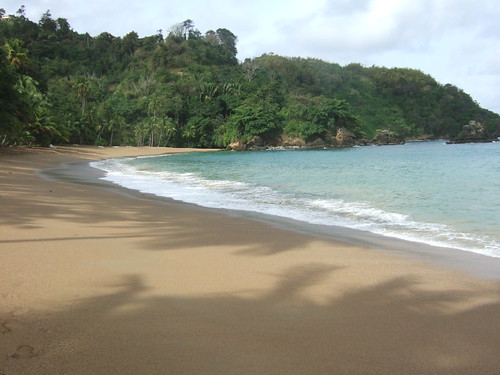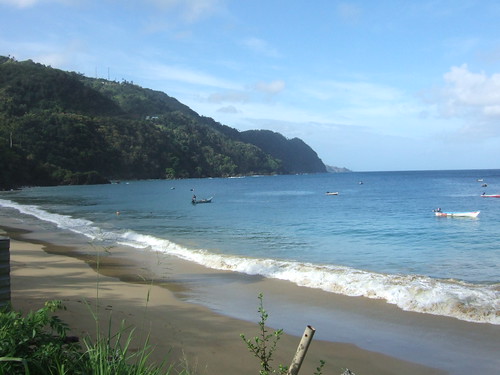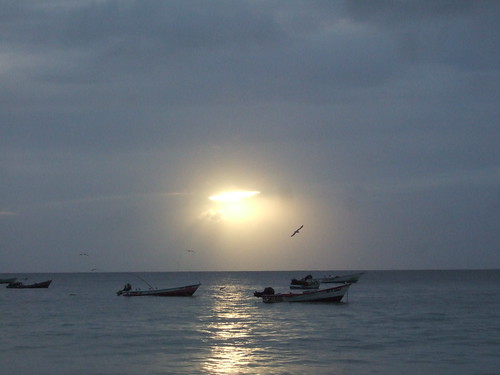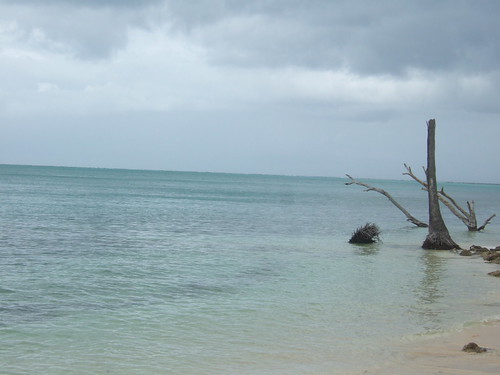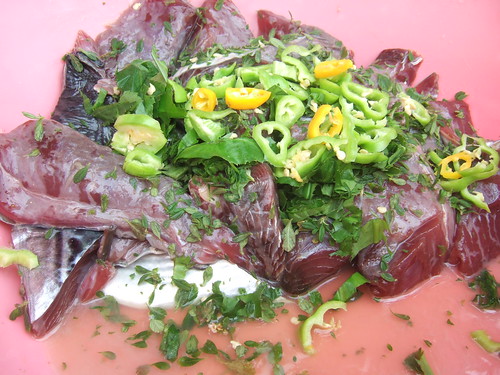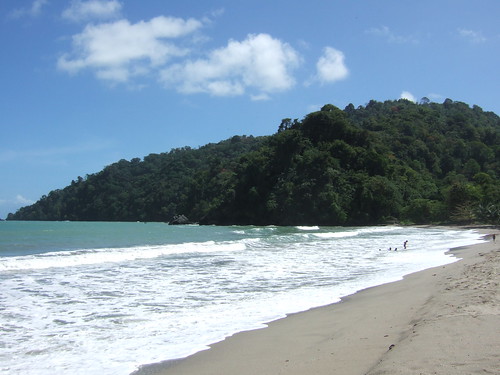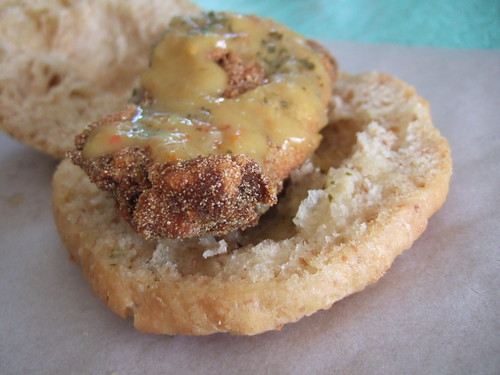We were about to fly back to Trinidad to spend our last night in the suburbs. I still had a few things on my list of food to eat and frankly, I was ready to accept defeat with a frown. While waiting for our flight outside the Tobago airport, however, the Dr. found a small cafeteria that sold bake ‘n’ salt fish. It’s the same fish sandwich like bake ‘n’ shark, only with dried salt fish, and usually served during breakfast. The bread was crumbly, almost like corn bread but white, and the fish crunchy and just had the right amount of saltiness.
As soon as we landed in Trinidad, we walked up to one of the rental booths to pick up a car. It was only $15 more than the rental price in Tobago and if I was going back to New York without moping, a car was the only way that the Dr. can think of to make sure my food mission was accomplished. First stop: Maracas Bay for the famous bake ‘n’ shark from Richard’s featured in Andrew Zimmern’s T&T episode. After his first bite, he said it was the best sandwich he’s ever tasted. Not in the country, but, like, ever. In Maracas Bay, there are plenty of food stalls waiting for beach goers to eat, but Richard’s is supposedly the only one with a queue.
But first, we stopped at a roti stand for lunch. We already had the buss-up-shut in Tobago, so this time we ordered the dhalpourri kind. Ground split peas is peppered in the dough, so at every tear, yellow powder sprinkled all over our plates and hands. My vegetarian version was filled with pumpkin, potatoes, peas and spinach, an amazing combination of colors and textures. I would skip the chicken filling for more of this if given another chance.
Of course, we weren’t going to finish our trip without a mishap. It took us almost an hour to get from the airport to downtown, past the lunch crowd and the heavy traffic. It was hot and hectic, two words I don’t like about cities, and we were lost. Uh-oh, what is that? I asked when the car all of a sudden started to cough. There was something wrong with the accelerator. (The wha-?) We had to ask a mechanic from some gas station to call our agency and explain what was wrong in order to get a new car delivered to where we were. Oh, and rain! Pouring rain! We were forced to wait inside the food court of a mall filled with smoke from the burger joint until the car agency clerk came (through the same traffic, no less).
Almost three hours after landing, we finally got a new car and started driving to Maracas Bay. The drive there lightened our spirits. It reminded us of driving in Kauai with its curvy roads hugging the cliffs. Going up the mountains, the air was cooler and the sun wasn’t so fierce. We were definitely ready to leave the city behind.
Forty-five minutes of beautiful scenery later, we slowed down to enter the lot to Richard’s. It was in the parking lot across the beach and a TT$10 fee was required to stay and eat. But oh, Richard’s, we were told, was closed for ten days. They renovatin’! My heart sank to my stomach. The Dr. looked over and he just knew. He knew that if we don’t find bake ‘n’ shark soon, my chin will start quivering. Uncle Sam’s to the rescue down the street. It was the only store open that late in the afternoon, but the short line was a good sign. We ordered two sandwiches and waited for our number to be called while we drank our first cold Caribs of the day. When we picked up our sandwiches, we added some green and chunky pepper sauce in it from the condiments corner. At first bite, the fish was flaky and warm. The white meat inside was deliciously tender and meaty. This wasn’t like V’s near Grand Riviere because it wasn’t overcooked and deep brown in color. It was my second bake ‘n’ shark in the country and I still wasn’t sure how to confirm that they really use shark. Both tasted like any other deep-fried white fish. Uncle Sam’s version was so good, we can’t imagine how Richard’s could be any better. (And I’m not just saying that out of spite either.)
It started to get dark when we drove down the mountain to the suburbs of St. Ann’s and Cascade. An upscale neighborhood, we saw nice cars next to us and white people playing rugby in Queen’s Park Savannah. Our room at Alicia’s Palace had a view of downtown Port of Spain and included a patio overlooking the valley. There was a restaurant on the premises and we could have sat next to the pool and used the billiard table, but all I really wanted was more local food before we leave the country.
After joining the residents for a jog up and down the hill, we cleaned up and started our drive back to the more harried part of town. Along the Savannah on Maraval Road were the Magnificent Seven, a group of mansions with European-style architecture but in dire need of repair. Under scaffoldings, they looked like giant gingerbread houses forgotten by time.
We joined the early Friday party on the streets of St. James. We parked the car and walked until we spotted our first roti stand. We joined the line not to buy, but to ask where the other street food stands were. The old Indian lady pointed to the blue umbrella across the street. He was also surrounded by a small group of hungry Trinidadians and I tip-toed to take a peek of what he was making.
As soon as I saw him scoop up a soupy channa curry on soft and fried bara bread and then add another under it, I knew they were what the locals call “doubles”. I must have looked too eager because he made me sit down on a stoop right behind him while he prepared ours. He ordered the Dr. to buy cold beers from the bar down the street and gave us enough napkins to help us eat without pouring curry sauce all over our shirts.
This is how you eat a doubles:
Forget the bake ‘n’ sharks, doubles is where it’s at. The next stop was the stand down the street with a stack of Styrofoam cups. The Dr. came up to the lady while I saved our seats on the stoop and asked what were in the plastic drums. As soon as she said pickled pig’s feet, or souse, there was just no stopping him.
Bright and tangy, pig’s trotters are brined in vinegar and a concoction of cucumbers, chilis, onions and garlic. They’re served cold, with tendon, skin and all, and you just have to use your hands to suck all the marrow from the bones. This is how you eat pickled pig’s feet:
We then crossed the street to get more beers and try the corn soup lady the next block over. Corn soup is corn soup, but the Trinidadian version was made of split-pea broth with chunks of corn and sticky dumplings. We had to walk around the avenue one more time just to make sure we didn’t miss anything else. We were full, but it seemed silly to stop then. We were on a roll. We decided against another bake ‘n’ shark and a roti–they were to come as the next morning’s purchases at the airport–and instead ordered more doubles and another serving of the pig’s feet.
Needless to say, we were content and happy that in one short night, I crossed off the last food item I wanted to try while in Trinidad and Tobago.
Related post/s:
Day 7 in Trinidad: Maracas Bay photos on Flickr
Day 7 in Trinidad: What to eat in St. James photos on Flickr
Day 6 was spent in Argyle Waterfalls and Pigeon Point, Tobago












